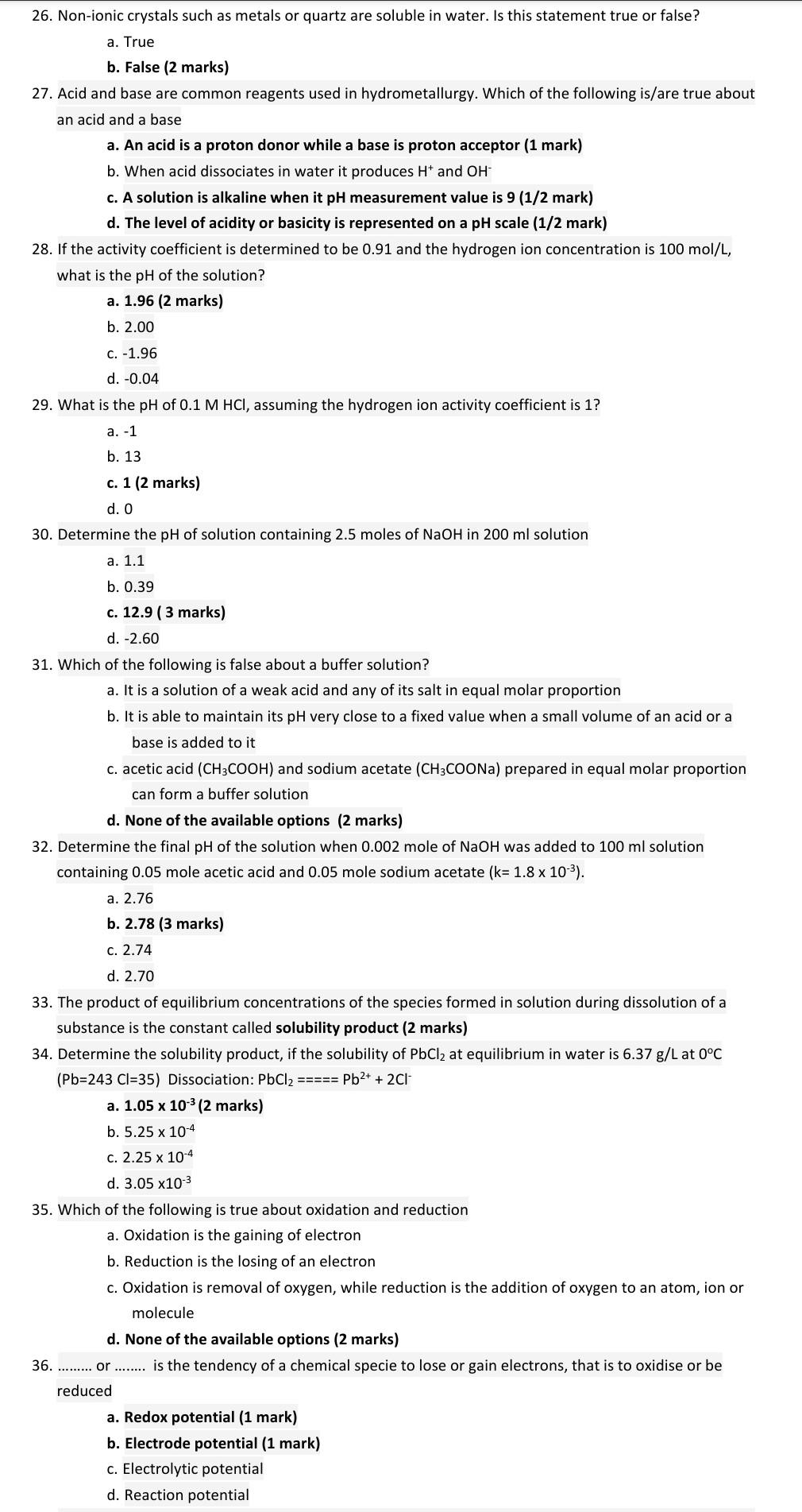Answered step by step
Verified Expert Solution
Question
1 Approved Answer
26. Non-ionic crystals such as metals or quartz are soluble in water. Is this statement true or false? a. True b. False (2 marks) 27.

26. Non-ionic crystals such as metals or quartz are soluble in water. Is this statement true or false? a. True b. False (2 marks) 27. Acid and base are common reagents used in hydrometallurgy. Which of the following is/are true about an acid and a base a. An acid is a proton donor while a base is proton acceptor (1 mark) b. When acid dissociates in water it produces Ht and OH c. A solution is alkaline when it pH measurement value is 9 (1/2 mark) d. The level of acidity or basicity is represented on a pH scale (1/2 mark) 28. If the activity coefficient is determined to be 0.91 and the hydrogen ion concentration is 100 mol/L, what is the pH of the solution? a. 1.96 (2 marks) b. 2.00 c. -1.96 d. -0.04 29. What is the pH of 0.1 M HCl, assuming the hydrogen ion activity coefficient is 1? a. -1 b. 13 c. 1 (2 marks) d. O 30. Determine the pH of solution containing 2.5 moles of NaOH in 200 ml solution a. 1.1 b. 0.39 c. 12.9 ( 3 marks) d. -2.60 31. Which of the following is false about a buffer solution? a. It is a solution of a weak acid and any of its salt in equal molar proportion b. It is able to maintain its pH very close to a fixed value when a small volume of an acid or a base is added to it C. acetic acid (CH3COOH) and sodium acetate (CH3COONa) prepared in equal molar proportion can form a buffer solution d. None of the available options (2 marks) 32. Determine the final pH of the solution when 0.002 mole of NaOH was added to 100 ml solution containing 0.05 mole acetic acid and 0.05 mole sodium acetate (k= 1.8 x 10-3). a. 2.76 b. 2.78 (3 marks) c. 2.74 d. 2.70 33. The product of equilibrium concentrations of the species formed in solution during dissolution of a substance is the constant called solubility product (2 marks) 34. Determine the solubility product, if the solubility of PbCl2 at equilibrium in water is 6.37 g/L at 0C (Pb=243 Cl=35) Dissociation: PbCl2 ===== Pb2+ + 2C1- a. 1.05 x 10- (2 marks) b. 5.25 x 10-4 c. 2.25 x 10-4 d. 3.05 x10-3 35. Which of the following is true about oxidation and reduction a. Oxidation is the gaining of electron b. Reduction is the losing of an electron c. Oxidation is removal of oxygen, while reduction is the addition of oxygen to an atom, ion or molecule d. None of the available options (2 marks) 36. ......... or ........ is the tendency of a chemical specie to lose or gain electrons, that is to oxidise be reduced a. Redox potential (1 mark) b. Electrode potential (1 mark) c. Electrolytic potential d. Reaction potential
Step by Step Solution
There are 3 Steps involved in it
Step: 1

Get Instant Access to Expert-Tailored Solutions
See step-by-step solutions with expert insights and AI powered tools for academic success
Step: 2

Step: 3

Ace Your Homework with AI
Get the answers you need in no time with our AI-driven, step-by-step assistance
Get Started


